Garden Glimpses: Midseason Form
It’s been an odd spring, weatherwise. We had an unseasonably warm start in late February, which popped the early bloomers like crocus and snowdrop, but then slowed to below normal temps, followed by drastic cold, with three consecutive nights dipping into the teens as March ended. That was nerve-wracking: so much was at a critical stage of development, and I could hardly cover the entire garden! I did put some weighted pots over the new corydalis “Beth Evans”, which was budded much earlier than I dreamed, and took my chances with the rest.

We came thru OK, except for the forsythia, whose blooms were just starting to break, and froze out almost completely. Fortunately I had been cutting forsythia to force indoors every few days since late January, and hacked away at it the day before the freeze, until I had five huge bouquets for the house, so I got my forsythia fix for the year, albeit the outdoor display was a total loss.
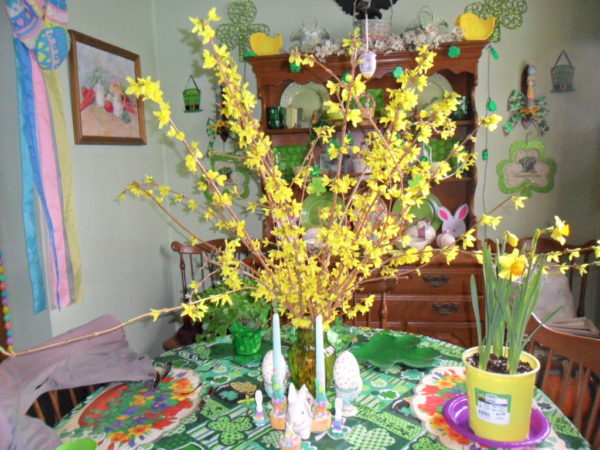
We’ve had two periods of excessive heat as well, with 70+ for two or three days running, so it’s been a sort of two-steps-forward, one-step-back kind of year. Pictures of my Easter table last year, when the holiday fell on April 4, two weeks earlier than in 2022, show large bouquets of daffodils, none of which were open by that date this year. We’re catching up now, though, and some of the new plantings from last fall have started to reveal their secrets.

Two that I’m especially enjoying have nothing whatever to do with spring bulbs, the featured player of the season. These are corydalis and anemone. Corydalis comes in a variety of types, but generally has clustered foliage, similar in appearance to rue or maidenhair fern, and full bloom heads of bugle-shaped blossoms. I have grown the yellow variety for more than a decade, but it didn’t like its transplant from Philly, and has dwindled to almost nothing. It’s a great performer when it likes where it is, though, blooming from spring to frost.
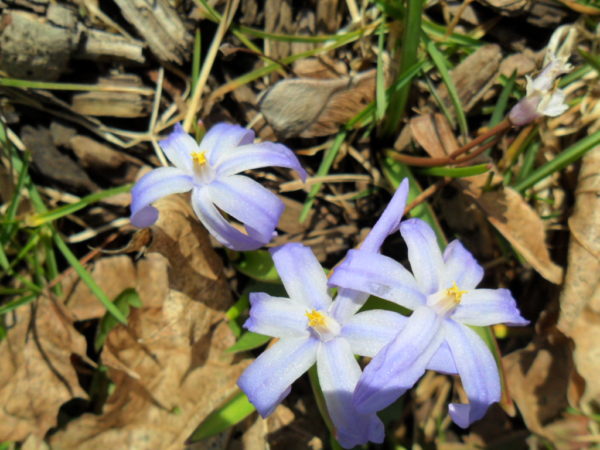
The variety I chose from the catalog last fall was Beth Evans, an early bloomer with coral-pink flowers, but just a short spring season. This was up and doing much earlier than expected, with shoots breaking the soil in early March. By the end of the month, it was in full swing, and both plantings were vibrant islands of color, bridging the floral gap between early small bulbs and midseason daffodils.

The other newcomer is anemone blanda, with leaves similar to native geranium and bright, daisy-like flowers, which hail originally from Australia and New Zealand, but do well in temperate regions across the globe. I bought a mix of white and blue, which is a deeper shade more akin to violet, and have been very pleased with the result. They are just coming into bloom now, a few weeks behind the corydalis, bright pops of eye-catching color.
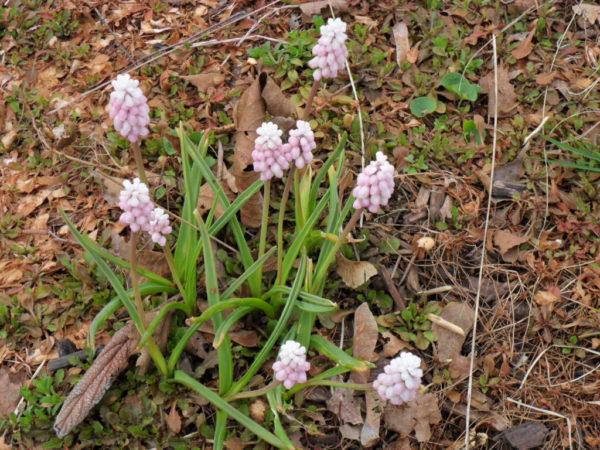
Squill and muscari are beginning to flower as well. I have several patches of white squill, veined in palest blue, and its baby blue cousin, with its raised bright yellow center. Mine have a tragic history here, having been victims in their first year to an invasion of hungry rabbits which took them all, leaf, bud and stem, right down to the ground. Last year the white variety returned fairly well, but bloomed sporadically, and the blue were virtually invisible, with just one or two blooms in a patch of 20 bulbs.
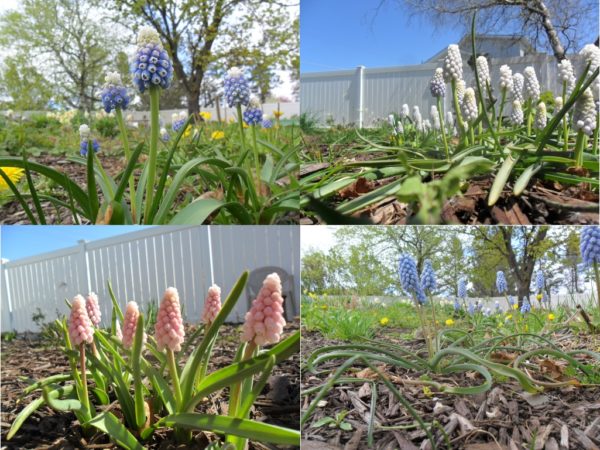
Bulbs rely on the strength taken in by the leaves in order to flower in the coming year, so I wasn’t expecting much from them, and was pleased they made any showing at all. But patience is the name of the game, and in this their third year, the white squill is almost up to speed, while the blue has graced me with 14 of 20 in bloom. I even have triple flowers on some bulbs, though most only have two, and some sport just a singleton.
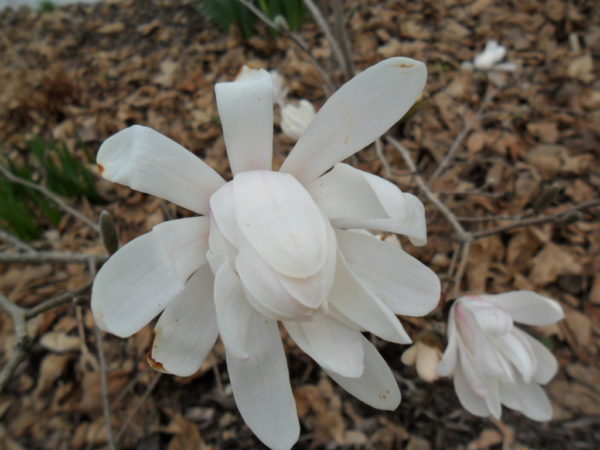
The most common variety of muscari (AKA grape hyacinth) are called bluebells, but the genus comes in a wide array of colors, several of which I cultivate. From the pure white of Siberian Tiger to the pale rose of Pink Sunrise, the pale ice blue of Baby’s Breath and the slightly deeper blue of Valerie Finnis, or the yellow-green of Golden Fragrance, there’s something to please everyone. I even have two tricolor varieties, Ocean Magic and Sky Blue, which are dark blue at the base, medium blue in the middle, and white at the top of the bloom.

Their heavyweight cousins, the hyacinths, are also beginning to come into their own as April reaches its midpoint. Most of these are planted near the witch hazel, now finished blooming and waiting for its leaves to emerge. Gypsy Queen, Sweet Invitation and Woodstock form inviting patches of pink, apricot and mauve, fronting an old stand of lavender heirloom hyacinths inherited from my parents. Last year I found some potted for sale as Easter plants, with pale yellow blooms that reminded me so much of the ones my grandmother had when I was a kid, that I had to have them. They’ve also returned nicely this year, in the bed just outside the kitchen door, where I can see them often.

Chionodoxa (AKA “Glory of the Snow”) is another early bloomer, with small starlike flowers in clusters on sturdy short stems. Similar to blue squill in appearance, these come in a bit later, and brighten the garden with vivid blue blanching at the center, surrounding a dot of yellow.
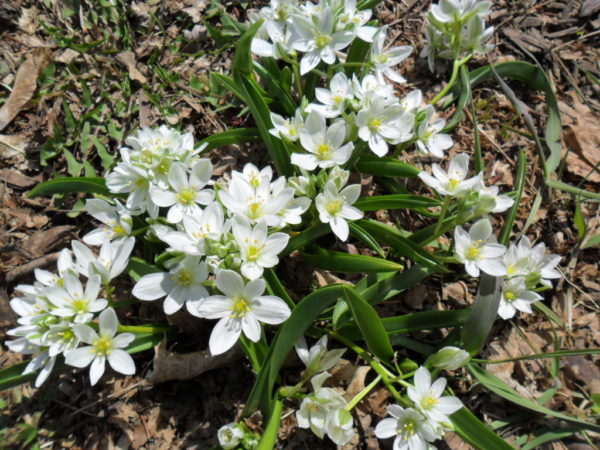
Chionodoxa pairs well with Ornithogalum Balansae, a shorter, earlier-blooming cousin of O. Umbellatum, the local Star of Bethlehem wildflower. Balansae is another new arrival in the garden, with a spreading habit and flowers held very close to the ground. These star-shaped blooms are white, but with undersides striated in pale green, which only open with sunlight, so when closed Balansae blossoms disappear into their bladelike foliage and are unimpressive. But when the sun comes out, what a show! Brilliant white centered with clustered pale-yellow stamens, they sparkle on bright spring mornings.
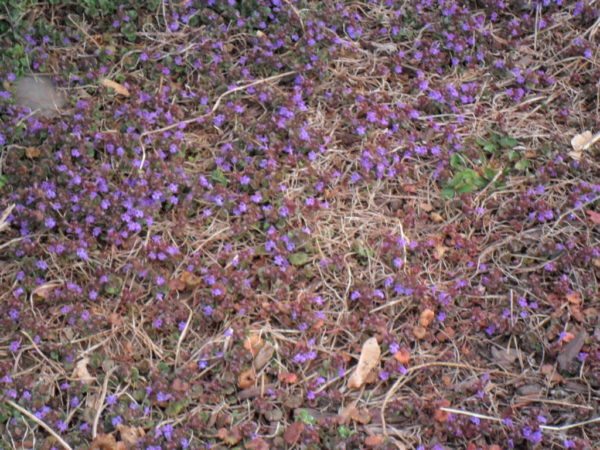
I even find beauty in the ubiquitous (and ineradicable) ground ivy, a pernicious low-growing creeper that has taken over large sections of the garden. If ground ivy has a saving grace, it may be that its density precludes many other weeds from taking root, while creating no barrier to the emergence of the perennials around which it surges; if it has a glory, that can be found in the few short weeks in spring when it is alight with miniscule vibrant purple blooms, forming a carpet of lavender.
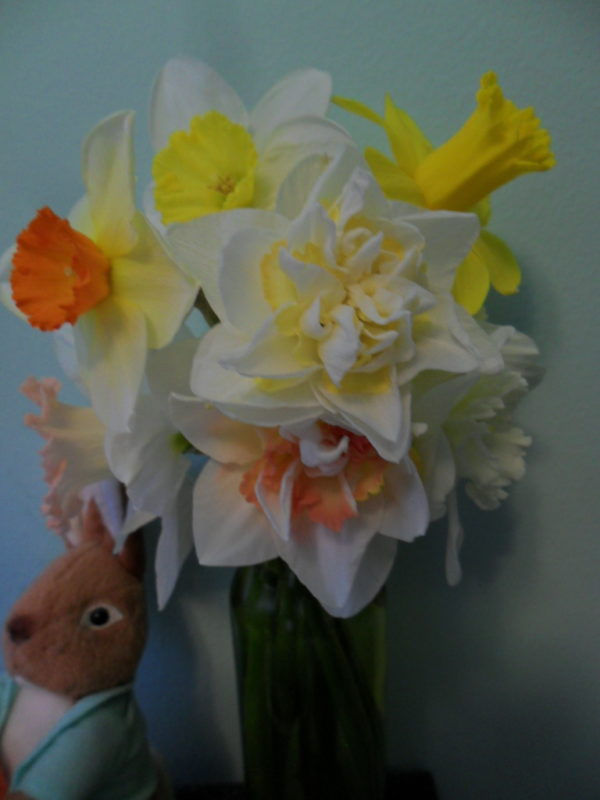
But my all-time favorite, my pride and joy, is of course the narcissus. I’m currently growing some 60 varieties, and I have a sneaking suspicion I’m not done yet!
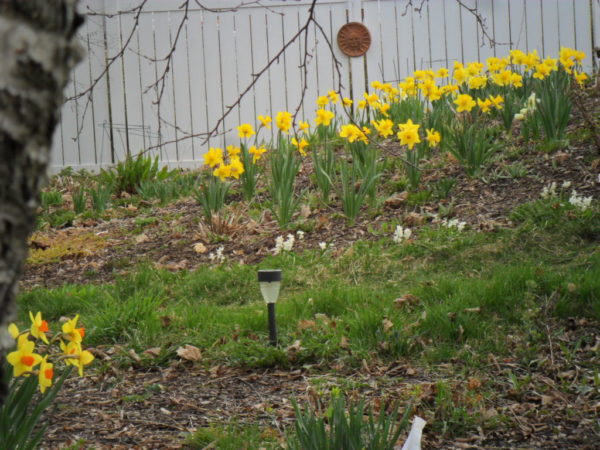
The naturalizing mix of daffodils which I bought three years ago for the sandmound bed is starting to fill in nicely. Viewed from above, it’s still just dots of color, albeit larger ones, but a cross view is looking lush and prolific. Most of the mix is composed of a large-flowered, tall strain in bold yellow, which blooms early, but there are a few later-booming varieties mixed in, some with multiple blossoms per stem, for an extended show lasting up to two months.
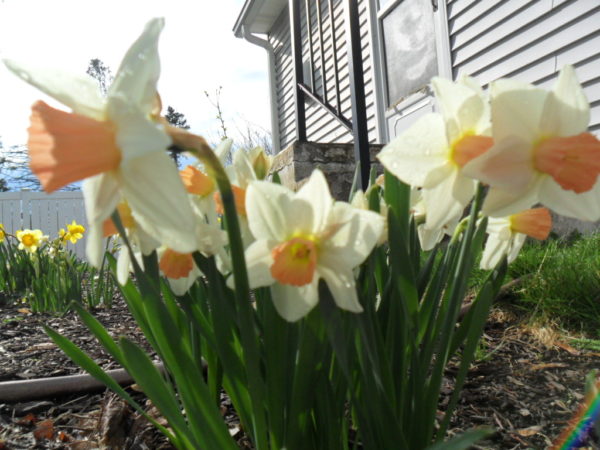
Banks of classic yellow daffodils are fine, but it’s in the showier varieties where my heart finds its home. Among the new entries this year are Orange Comet, a medium-sized narcissus with tangerine trumpets and reflexed creamy white petals; and Golden Echo, a shorter variety with elongated cups in bright lemon yellow, which bleed into the bottom third of the white fringe petals.
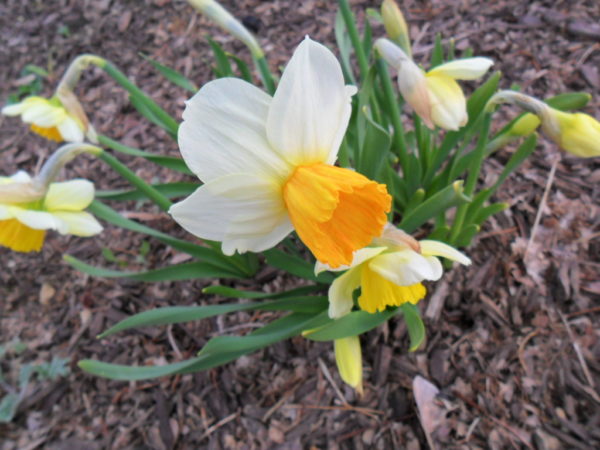
Perhaps my favorite color combination for narcissus is yellow and orange; there must be upwards of a dozen variations on this theme on the property, the latest arrival of which is Loveday, a tall hybrid with wide bright yellow petals ringing a center that opens in a matching color, then quickly matures to an intense orange. Cha Cha is another new winner, a more diminutive flower, with off-white petals framing salmon pink cups that bleed into a greenish base.
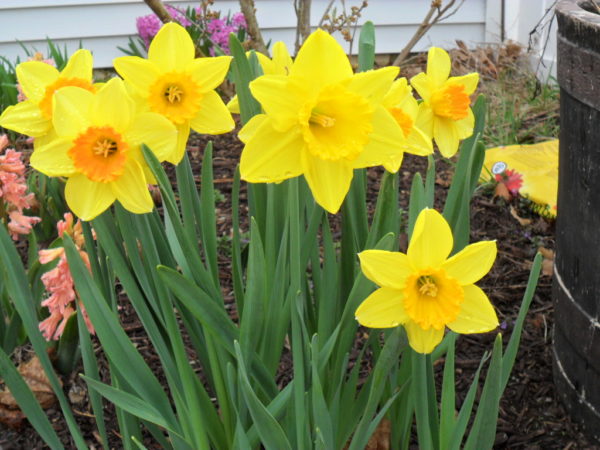
An of course all the old favorites are returning, like pastel pink and white British Gamble, citrus bright Brackenhurst, like a burst of lemon and tangerine, and romantic Barrett Browning, with nodding white and orange blooms. Some of the second-year plantings have expanded, some are holding their own, and some have dwindled. Light levels might be an issue – in the first year everything was planted in full sun, but year two had some partial shade plantings. These are still full sun this early, when the bulbs are blooming before the trees have leafed out, but may not be getting enough sun to properly revitalize them after the shade kicks in, while they are still storing energy through their foliage before dying back in June.

But it could also be a fertilization issue; new bulbs have been highly fertilized and raised in prime conditions by the growers, but that only lasts a season. This year I’ll be following up the bloom period with a granular bulb booster sprinkled at the base of each plant, so we’ll give the dwindlers another year to flower before deciding they may need to be re-sited. In the meantime, I’ll just kick back and enjoy the show!
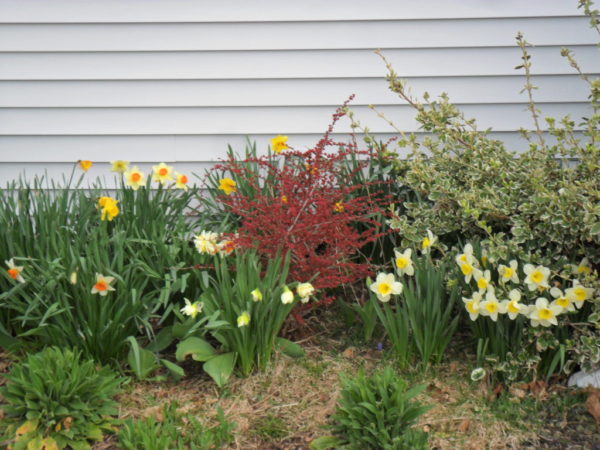
I’ve crossed off one more item on my gardening bucket list with the acquisition last week of hellebores, a plant I’ve wanted on the property for years. Also known as “Lenten Rose” from its similarity to that flower and a habit of blooming in the pre-Easter period, hellebores remain essentially evergreen year-round, and can bloom as early as December in some climates, with blossoms that persist for months. Here they’ll likely start to open in late January or early February.

Hellebores are slow to mature, and can take three years or more before they bloom, so unless you have the patience of Job (which I definitely do not!), it’s best to buy them large. But that invariably means greater expense; you can expect to pay up to $40 per plant for fully matured specimens. I got mine at the local perennial farm for $25 apiece, a decent price, but five took a good bite out of my garden budget. Three are flowering, two others will likely not set blooms until next year. Hellebores like shade but will tolerate some morning sun, so siting all five of these together may prove problematic in my yard, but they’ll be fine in their pots for now, as I lug them from point to point, to see where they like it best before committing them to the soil.
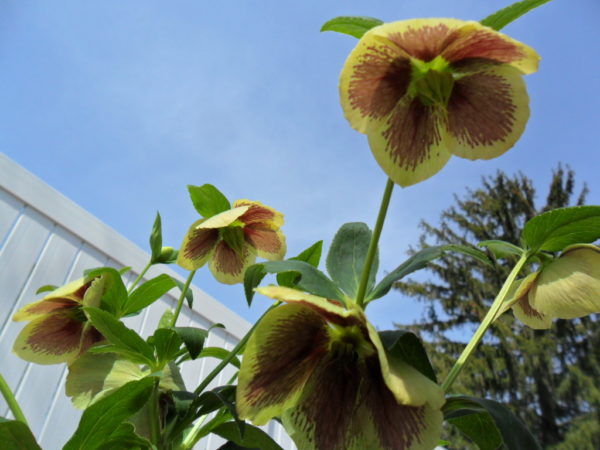
I checked out the farm’s website before opening day to determine which varieties I liked best, and chose four: “Romantic Getaway” and “Rio Carnival”, both single-flowered with pale yellow or white borders lining burgundy to maroon petals; “Tropical Sunset”, a deeper yellow veined in burgundy; and “True Love” a dark dusty mauve double-flowered variety with dramatic yellow centers. While there I also saw “Maid of Honor” in bloom, another double-flowered strain, and couldn’t resist its delicate pink-purple blossoms.
The downside to hellebores is quite literal – their flowers are downturned, making it difficult sometimes to enjoy their beautiful blooms. But it’s a plant I have adored from afar for decades, and I’m so happy to finally call them my own.
As April enters its final weeks and Easter becomes a memory, we’re past peak season for spring bulbs, but there are many delights that still await!


2 comments, add yours.
edna
So much work! Thank you for sharing! It’s really come along.
Laurien
Beautiful Alex! Loved seeing all the varieties of plants with their gorgeous colours! Your garden really has filled in since last year. I hope you find the perfect spot for your hellebores. They look so elegant! Happy gardening!